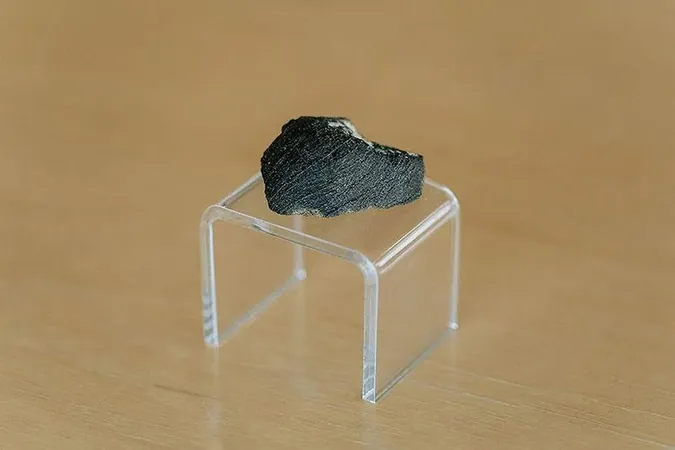
The Astonishing Secrets of Mars Revealed by a Forgotten Meteorite
2024-11-20
Author: Sarah
What a Misplaced Meteorite Told Us About Mars
In a remarkable twist of fate, an 800-gram piece of Martian rock known as the Lafayette meteorite has been shedding light on the red planet's enigmatic past. This meteorite was inadvertently stored away at Purdue University for decades, only to be rediscovered in 1931 when scientists recognized its extraterrestrial origin. But what critical insights about Mars have emerged from this seemingly unremarkable rock?
Approximately 11 million years ago, while Earth was thriving with the early ancestors of mammals and tropical forests, Mars was a desolate, icy wasteland. A catastrophic cosmic event struck Mars, propelling debris into space, marking the birth of the Lafayette meteorite. Today, it serves as a monumental piece of the Martian puzzle.
New research led by Marissa Tremblay, an assistant professor at Purdue’s Department of Earth, Atmospheric, and Planetary Sciences, has uncovered astonishing clues embedded within the meteorite. While the rock itself is an igneous formation that originated 1.4 billion years ago from basaltic lava, some of the minerals it holds reveal a more recent history—dating back 742 million years when they formed in the presence of liquid water.
Tremblay explains, 'We believe that during this time, there wasn’t an abundance of surface water on Mars. Instead, melting permafrost likely contributed to the liquid water found within these minerals, driven by sporadic magmatic activity still occurring on the planet today.'
The Lafayette meteorite is a member of the Nakhlite group, indicating a lineage traced back to significant volcanic activity on Mars, specifically in regions such as Elysium, Syrtis Major Planum, or the massive Tharsis volcanic area.
One of the key minerals analyzed in this research is iddingsite, which forms when basalt reacts with water. This mineral's presence suggests that some form of liquid water had once permeated the Martian landscape—a tantalizing prospect for astrobiologists hunting for signs of past life on the planet.
However, studying meteorites presents challenges; they can be altered by the intense heat during their initial impact and the fiery re-entry into Earth’s atmosphere. Remarkably, the Lafayette meteorite maintained its integrity as it traveled through space for 11 million years.
Co-author Ryan Ickert, a senior research scientist at Purdue, utilized a combination of unstable and stable isotopes to unravel these intricate geological interactions. He emphasized the uniqueness of the Lafayette meteorite, which shows clear evidence of water reaction. 'We’ve established that this meteorite distinctly experienced water interaction, dating back to a period when it was altered,' he asserted.
Employing modern techniques that involved isotopes of Argon to date the mineral exposure to water, the researchers concluded that this alteration event occurred 742 million years ago, likely instigated by volcanic activity that melted subsurface ice, allowing the water to seep into the cracks of the igneous rock.
The origin of planets and their development remains a fascinating field of study, filled with many unanswered questions. As researchers delve deeper into this kind of extraterrestrial material, they are slowly piecing together the history of our Solar System—a jigsaw puzzle where meteorites are critical pieces.
Tremblay notes the importance of accurately dating these celestial bodies, as it allows for a better understanding of when conditions such as liquid water might have existed on other planets. She concluded, 'With our new methods, we can explore not just Mars but potentially apply these techniques to other planetary bodies in search for signs of past life.'
Who would have thought that a mere drawer at Purdue University could house such profound revelations about Mars? This meteorite, long hidden from sight, has opened a window into the Martian past, sparking a renewed interest in the search for evidence of life beyond Earth. Stay tuned, as further breakthroughs from this hauntingly silent rock continue to captivate the scientific community and the world alike!




 Brasil (PT)
Brasil (PT)
 Canada (EN)
Canada (EN)
 Chile (ES)
Chile (ES)
 España (ES)
España (ES)
 France (FR)
France (FR)
 Hong Kong (EN)
Hong Kong (EN)
 Italia (IT)
Italia (IT)
 日本 (JA)
日本 (JA)
 Magyarország (HU)
Magyarország (HU)
 Norge (NO)
Norge (NO)
 Polska (PL)
Polska (PL)
 Schweiz (DE)
Schweiz (DE)
 Singapore (EN)
Singapore (EN)
 Sverige (SV)
Sverige (SV)
 Suomi (FI)
Suomi (FI)
 Türkiye (TR)
Türkiye (TR)